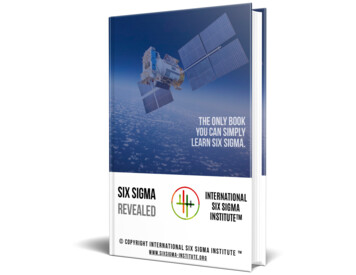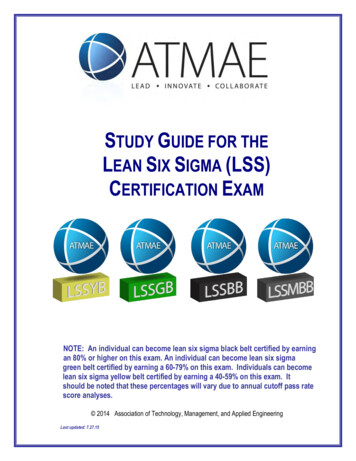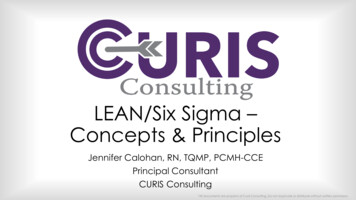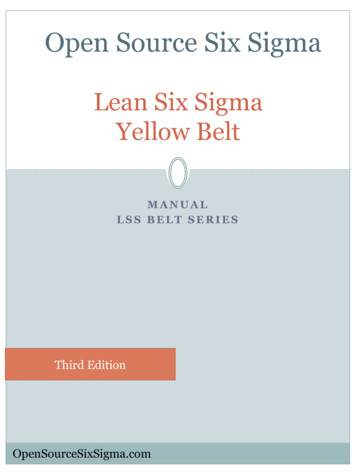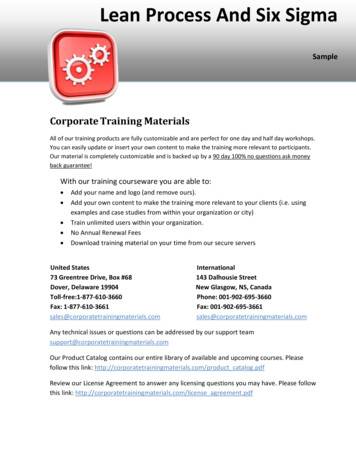
Transcription
Lean Process And Six SigmaSampleCorporate Training MaterialsAll of our training products are fully customizable and are perfect for one day and half day workshops.You can easily update or insert your own content to make the training more relevant to participants.Our material is completely customizable and is backed up by a 90 day 100% no questions ask moneyback guarantee!With our training courseware you are able to: Add your name and logo (and remove ours).Add your own content to make the training more relevant to your clients (i.e. usingexamples and case studies from within your organization or city)Train unlimited users within your organization.No Annual Renewal FeesDownload training material on your time from our secure serversUnited States73 Greentree Drive, Box #68Dover, Delaware 19904Toll-free:1-877-610-3660Fax: International143 Dalhousie StreetNew Glasgow, NS, CanadaPhone: 001-902-695-3660Fax: omAny technical issues or questions can be addressed by our support teamsupport@corporatetrainingmaterials.comOur Product Catalog contains our entire library of available and upcoming courses. Pleasefollow this link: http://corporatetrainingmaterials.com/product catalog.pdfReview our License Agreement to answer any licensing questions you may have. Please followthis link: http://corporatetrainingmaterials.com/license agreement.pdf
TABLE OF CONTENTSPreface .3What is Courseware? . 3How Do I Customize My Course? . 3Materials Required . 4Maximizing Your Training Power. 5Icebreakers .6Icebreaker: Friends Indeed. 7Training Manual Sample.8Sample Module: Understanding Lean . 9Instructor Guide Sample. 15Sample Module: Understanding Lean . 16Activities . 28Quick Reference Sheets. 31Certificate of Completion . 33PowerPoint Sample. 35Full Course Table of Contents . 39
PrefaceWhat is Courseware?Welcome to Corporate Training Materials, a completely new trainingexperience!Our courseware packages offer you top-quality training materials thatare customizable, user-friendly, educational, and fun. We provide yourmaterials, materials for the student, PowerPoint slides, and a takehome reference sheet for the student. You simply need to prepare andtrain!Best of all, our courseware packages are created in Microsoft Office and can be opened using anyversion of Word and PowerPoint. (Most other word processing and presentation programs supportthese formats, too.) This means that you can customize the content, add your logo, change the colorscheme, and easily print and e-mail training materials.How Do I Customize My Course?Customizing your course is easy. To edit text, just click and type as you would with any document. This isparticularly convenient if you want to add customized statistics for your region, special examples foryour participants’ industry, or additional information. You can, of course, also use all of your wordprocessor’s other features, including text formatting and editing tools (such as cutting and pasting).To remove modules, simply select the text and press Delete on your keyboard. Then, navigate to theTable of Contents, right-click, and click Update Field. You may see a dialog box; if so, click “Update entiretable” and press OK.(You will also want to perform this step if you add modules or move them around.)If you want to change the way text looks, you can format any piece of text any way you want. However,to make it easy, we have used styles so that you can update all the text at once.If you are using Word 97 to 2003, start by clicking the Format menu followed by Styles and Formatting.In Word 2007 and 2010 under the Home tab, right-click on your chosen style and click Modify. That willthen produce the Modify Style options window where you can set your preferred style options.
For example, if we wanted to change our Heading 1 style, used for Module Titles, this is what we woulddo:Now, we can change our formatting and it will apply to all the headings in the document.For more information on making Word work for you, please refer to Word 2007 or 2010 Essentials byCorporate Training Materials.Materials RequiredAll of our courses use flip chart paper and markers extensively. (If you prefer, you can use a whiteboardor chalkboard instead.)We recommend that each participant have a copy of the Training Manual, and that you review eachmodule before training to ensure you have any special materials required. Worksheets and handouts areincluded within a separate activities folder and can be reproduced and used where indicated. If youwould like to save paper, these worksheets are easily transferrable to a flip chart paper format, insteadof having individual worksheets.
We recommend these additional materials for all workshops: Laptop with projector, for PowerPoint slides Quick Reference Sheets for students to take home Timer or watch (separate from your laptop) Masking tape Blank paperMaximizing Your Training PowerWe have just one more thing for you before you get started. Our company is built for trainers, bytrainers, so we thought we would share some of our tips with you, to help you create an engaging,unforgettable experience for your participants. Make it customized. By tailoring each course to your participants, you will find that your resultswill increase a thousand-fold.oUse examples, case studies, and stories that are relevant to the group.oIdentify whether your participants are strangers or whether they work together. Tailoryour approach appropriately.oDifferent people learn in different ways, so use different types of activities to balance itall out. (For example, some people learn by reading, while others learn by talking aboutit, while still others need a hands-on approach. For more information, we suggestExperiential Learning by David Kolb.) Make it fun and interactive. Most people do not enjoy sitting and listening to someone else talkfor hours at a time. Make use of the tips in this book and your own experience to keep yourparticipants engaged. Mix up the activities to include individual work, small group work, largegroup discussions, and mini-lectures. Make it relevant. Participants are much more receptive to learning if they understand why theyare learning it and how they can apply it in their daily lives. Most importantly, they want toknow how it will benefit them and make their lives easier. Take every opportunity to tie whatyou are teaching back to real life. Keep an open mind. Many trainers find that they learn something each time they teach aworkshop. If you go into a training session with that attitude, you will find that there can be anamazing two-way flow of information between the trainer and trainees. Enjoy it, learn from it,and make the most of it in your workshops.And now, time for the training!
IcebreakersEach course is provided with a wide range of interactive Icebreakers. The trainer can utilize anIcebreaker to help facilitate the beginning of the course, as it helps “break the ice” with theparticipants. If the participants are new to each other, an icebreaker is a great way to introduceeveryone to each other. If the participants all know each other it can still help loosen up theroom and begin the training session on positive note. Below you will see one of the icebreakersthat can be utilized from the Icebreakers folder.
Icebreaker: Friends IndeedPurposeHave the participants moving around and help to make introductions to each other.Materials Required Name card for each personMarkersPreparationHave participants fill out their name card. Then, ask participants to stand in a circle, shoulder toshoulder. They should place their name card at their feet. Then they can take a step back. Youas the facilitator should take the place in the center of the circle.ActivityExplain that there is one less place than people in the group, as you are in the middle and willbe participating. You will call out a statement that applies to you, and anyone to whom thatstatement applies must find another place in the circle.Examples: Friends who have cats at homeFriends who are wearing blueFriends who don’t like ice creamThe odd person out must stand in the center and make a statement.The rules: You cannot move immediately to your left or right, or back to your place.Let’s be adults: no kicking, punching, body-checking, etc.Play a few rounds until everyone has had a chance to move around.
Training Manual SampleOn the following pages is a sample module from our Training Manual. Each of our coursescontains twelve modules with three to five lessons per module. It is in the same format andcontains the same material as the Instructor Guide, which is then shown after the TrainingManual sample, but does not contain the Lesson Plans box which assists the trainer duringfacilitation.The Training Manual can be easily updated, edited, or customized to add your business nameand company logo or that of your clients. It provides each participant with a copy of thematerial where they can follow along with the instructor.
Six Sigma is the most importanttraining thing we have ever had.It’s better than going to HarvardBusiness School.Jack WelchSample Module: Understanding LeanLean and Six Sigma are buzz-words we hear in business all of thetime. Before we get started, let’s make sure we all understand justwhat we mean by “lean” and “Six Sigma”.
About Six Sigma Six Sigma is a structured, data-driven process of solving critical issuesfrom a business perspective that we haven’t been able to solve withcurrent methodology. Six Sigma is the single most effective problem-solving methodology forimproving business and organizational performance. The common measurement scale is called the Sigma capability or Z and is a universal scale. It is ascale like a yardstick measuring inches or a thermometer measuring temperature. The scale allows us to compare business processes in terms of the capability to stay within thequality limits established for that process. The Sigma scale measures Defects per Million Opportunities (DPMO). Six Sigma equates to 3.4defects per million opportunities.What Six Sigma is and is not: Six Sigma is not an add-on to normal business activities. It is an integrated part of the improvement process. Six Sigma is management methodology driven by data. Six Sigma focuses on projects that will produce measurable business results. Six Sigma is not a standard, a certification or a metric like percentage. The central idea behind Six Sigma is that if you can measure how many" defects” you have in aprocess, you can systematically determine how to eliminate those and approach “zero defects”. Sigma is a value from 1 to 6 that signifies the maximum number of defects per million:o 1 Sigma 690,000 defects/million 31% accurateo 2 Sigma 308,537 defects/million 69.1463% accurateo 3 Sigma 66,807 defects/million 93.3193% accurateo 4 Sigma 6,210 defects/million 99.3790% accurateo 5 Sigma 233 defects/million 99.9767% accurateo 6 Sigma 3.4 defects/million 99.999997% accurate Six Sigma is about reducing variation. Six Sigma find out the facts before acting.
About Lean“Lean” means continuously improving towards the ideal and achieving theshortest possible cycle time through the tireless reduction of waste. It is focused on eliminating waste in all processes It is about expanding capacity by reducing costs and shortening cycletimes It is about understanding what is important to the customer It is not about eliminating peopleExamples of Lean Projects: Reduced inventory Reduced floor space Quicker response times and shorter lead times Decreased defects, rework, scrap Increased overall productivity
History behind LeanThe phrase “lean manufacturing” was coined in the 1980's and has its roots inthe Toyota Production System. (See later in this module)Most of the basic goals of lean manufacturing are common sense, and somefundamental thoughts have been traced back to the writings of BenjaminFranklin.Henry Ford cited Franklin as a major influence on his lean business practices, which included Just-in-timemanufacturing. The founders of Toyota designed a process with inspiration from Henry Ford and theirvisits to the United States to observe the assembly line and mass production that had made Ford rich.The process is called the Toyota Production System, and is the fundamental principle of leanmanufacturing.Two books have since shaped the ideologies of Lean: “The machine that changed the world” (1990) and“Lean Thinking” (1996).
Toyota Production SystemsThe Toyota Production System (TPS) is a mindset and management system thatembraces continuous improvement. TPS organizes manufacturing and logistics,including interaction with suppliers and customers. Originally called "Just inTime Production," it builds on the approach created by the founders of Toyota.TPS revolves around 5 simple steps:1. Define Value of your product Make it according to Customer needs and Customer Defined2. Identify Value Stream of your product Follow the product and identify unnecessary actions3. Study the Flow your product Eliminate All Waste4. Make only what the customer orders Produce Just In Time for Demand5. Strive for Perfection Continuous Improvement. Good enough is never enough.
The Toyota PreceptsThe five methods defined by Toyota contain some basic principles:1. CHALLENGE: Form a long-term vision, meeting challenge with courage andcreativity to realize your dreams.o Create Value through Manufacturing and Delivery of Products andServicesoNurture a spirit of ChallengeoAlways have a Long Range PerspectiveoThorough Consideration in Decision Making2. KAIZEN: Improve your business operations continuously, always driving for innovation andevolution.o Have a Kaizen Mind and Innovative Thinking (See later this module)oBuild Lean Systems and StructureoPromote Organizational Thinking3. GENCHI GENBUTSU (Go and see): Go to the source to find the facts to make correct decisions,build consensus, and achieve goals at our best speed.o Genchi Genbutsu (Go and See)oLead with Consensus BuildingoCreate Commitment to Achievement4. RESPECT: Respect others, make every effort to understand each other, take responsibility anddo your best to build mutual trust.o Respect for Stakeholders and communityoDevelop Mutual Trust and Mutual ResponsibilityoBe Sincere, transparent and open in all Communication5. TEAMWORK: Stimulate personal and professional growth, share the opportunities ofdevelopment, and maximize individual and team performance.o Have Commitment to Education and DevelopmentoHave Respect for the Individual; Realizing Consolidated Power as a Team
Instructor Guide SampleOn the following pages is a sample module from our Instructor Guide. It provides the instructorwith a copy of the material and a Lesson Plans box. Each Instructor Guide and Training Manualmirrors each other in terms of the content. They differ in that the Instructor Guide iscustomized towards the trainer, and Training Manual is customized for the participant.The key benefit for the trainer is the Lesson Plan box. It provides a standardized set of tools toassist the instructor train that particular lesson. The Lesson Plan box gives an estimated time tocomplete the lesson, any materials that are needed for the lesson, recommended activities, andadditional points to assist in delivering the lessons such as Stories to Share and Delivery Tips.
Six Sigma is the most importanttraining thing we have ever had.It’s better than going to HarvardBusiness School.Jack WelchSample Module: Understanding LeanLean and Six Sigma are buzz-words we hear in business all of thetime. Before we get started, let’s make sure we all understand justwhat we mean by “lean” and “Six Sigma”.
About Six SigmaEstimated Time10 minutesTopic ObjectiveTo understand that “Six Sigma” is a methodology for improving processes.Topic SummaryMaterials Required Six Sigma is a structured, data-driven process of solving critical issuesfrom a business perspective that we haven’t been able to solve withcurrent methodology. Six Sigma is the single most effective problem-solving methodologyfor improving business and organizational performance. The common measurement scale is called the Sigma capability or Zand is a universal scale. It is a scale like a yardstick measuring inchesor a thermometer measuring temperature. The scale allows us to compare business processes in terms of thecapability to stay within the quality limits established for thatprocess. The Sigma scale measures Defects per Million Opportunities (DPMO).Six Sigma equates to 3.4 defects per million opportunities.List the activities below on a flip chart.Before the workshop, write the following on the flip chart:For every 300,000 letters deliveredWith 99% delivery rate With Six Sigma Planning ChecklistFor every 500,000 computer startsWith 99% start rate With Six Sigma Out of 450,000 order lines per monthWith 99% order fills With Six Sigma Have the group work on the numbers below. Here are the answers:Recommended ActivityFor every 300,000 letters deliveredWith 99% delivery rate 3,000 wrong deliveriesWith Six Sigma 1 wrong deliveryFor every 500,000 computer startsWith 99% start rate 5,000 crashes
With Six Sigma 2 crashesOut of 450,000 order lines per monthWith 99% order fills 4,500 broken promisesWith Six Sigma 2 broken promisesMotorola, the place where Six Sigma began, saved 2.2 billion in four yearsusing Six Sigma.Stories to ShareGE saved 2 billion over 3 years implementing Six Sigma. Jack Welch, formerCEO became an ambassador of Six Sigma and inspired Corporate America,and the rest of the world to follow.It is important to show the group that Six Sigma is not just about improvingefficiencies in a factory or for manufacturing. Here are some examples:Delivery TipsReview Questions Call Centers (response / resolution time) Ordering Systems (order time to deliver, order accuracy) Hospital Systems (Patient Flow) Human Resource Management (Customer Service Training) Retail Services (Wait time, Customer Satisfaction)What is Six Sigma? What and where is it used?
Six Sigma is a structured, data-driven process of solving critical issuesfrom a business perspective that we haven’t been able to solve withcurrent methodology. Six Sigma is the single most effective problem-solving methodology forimproving business and organizational performance. The common measurement scale is called the Sigma capability or Z and is a universal scale. It is ascale like a yardstick measuring inches or a thermometer measuring temperature. The scale allows us to compare business processes in terms of the capability to stay within thequality limits established for that process. The Sigma scale measures Defects per Million Opportunities (DPMO). Six Sigma equates to 3.4defects per million opportunities.What Six Sigma is and is not: Six Sigma is not an add-on to normal business activities. It is an integrated part of the improvement process. Six Sigma is management methodology driven by data. Six Sigma focuses on projects that will produce measurable business results. Six Sigma is not a standard, a certification or a metric like percentage. The central idea behind Six Sigma is that if you can measure how many" defects” you have in aprocess, you can systematically determine how to eliminate those and approach “zero defects”. Sigma is a value from 1 to 6 that signifies the maximum number of defects per million:o 1 Sigma 690,000 defects/million 31% accurateo 2 Sigma 308,537 defects/million 69.1463% accurateo 3 Sigma 66,807 defects/million 93.3193% accurateo 4 Sigma 6,210 defects/million 99.3790% accurateo 5 Sigma 233 defects/million 99.9767% accurateo 6 Sigma 3.4 defects/million 99.999997% accurate Six Sigma is about reducing variation. Six Sigma find out the facts before acting.
About LeanEstimated Time10 minutesTopic ObjectiveTo understand what is meant by the term “lean”.“Lean” means continuously improving towards the ideal and achieving theshortest possible cycle time through the tireless reduction of waste.Topic Summary It is focused on eliminating waste in all processes It is about expanding capacity by reducing costs and shortening cycletimes It is about understanding what is important to the customer (e.g.value) It is not about eliminating peopleExamples of Lean ProjectsRecommended Activity Reduced inventory Reduced floor space Quicker response times and shorter lead times Decreased defects, rework, scrap Increased overall productivityHave group share examples of lean activities in their organizations.In Lean, Value Added means:Delivery Tips Customers are willing to pay for it It physically changes the product It’s done right the first timeIn Lean, Non Value-Added means: It is not essential to produce output Does not add value to the outputThis Includes: Defects, errors, omission
Review Questions Preparations/setup, control/inspection Over-production, processing, inventory Transporting, motion, waiting, delaysWhat are examples of Lean Projects?“Lean” means continuously improving towards the ideal and achieving theshortest possible cycle time through the tireless reduction of waste. It is focused on eliminating waste in all processes It is about expanding capacity by reducing costs and shortening cycletimes It is about understanding what is important to the customer It is not about eliminating peopleExamples of Lean Projects: Reduced inventory Reduced floor space Quicker response times and shorter lead times Decreased defects, rework, scrap Increased overall productivity
History behind LeanEstimated Time10 minutesTopic ObjectiveUnderstand how “lean” became an integral part of modern manufacturingand corporate ideologies.The phrase “lean manufacturing” was coined in the 1980's and has its rootsin the Toyota Production System. (See later in this module)Most of the basic goals of lean manufacturing are common sense, and somefundamental thoughts have been traced back to the writings of BenjaminFranklin.Topic SummaryHenry Ford cited Franklin as a major influence on his lean business practices,which included Just-in-time manufacturing.The founders of Toyota designed a process with inspiration from Henry Fordand their visits to the United States to observe the assembly line and massproduction that had made Ford rich. The process is called the ToyotaProduction System, and is the fundamental principle of lean manufacturing.Two books have since shaped the ideologies of Lean: “The machine thatchanged the world” (1990) and “Lean Thinking” (1996).Materials RequiredCopy of “Lean Thinking” if possible.Planning ChecklistObtain a copy of “Lean Thinking” before the workshopRecommended ActivityPass around “Lean Thinking” for participants to look at.Stories to ShareIn 1910 Henry Ford moves his factory into Highland Park, the “birthplace oflean manufacturing”, with continuous flow of parts.
The phrase “lean manufacturing” was coined in the 1980's and has its roots inthe Toyota Production System. (See later in this module)Most of the basic goals of lean manufacturing are common sense, and somefundamental thoughts have been traced back to the writings of BenjaminFranklin.Henry Ford cited Franklin as a major influence on his lean business practices, which included Just-in-timemanufacturing. The founders of Toyota designed a process with inspiration from Henry Ford and theirvisits to the United States to observe the assembly line and mass production that had made Ford rich.The process is called the Toyota Production System, and is the fundamental principle of leanmanufacturing.Two books have since shaped the ideologies of Lean: “The machine that changed the world” (1990) and“Lean Thinking” (1996).
Toyota Production SystemsEstimated Time10 minutesTopic ObjectiveUnderstanding the TPS system on which modern manufacturing is modeledupon.The Toyota Production System (TPS) is a mindset and management systemthat embraces continuous improvement.TPS organizes manufacturing and logistics, including interaction withsuppliers and customers.Originally called "Just In Time Production," it builds on the approach createdby the founders of Toyota.TPS revolves around 5 simple steps:Topic Summary1. Define Value of your product Make it according to Customer needsand Customer Defined2. Identify Value Stream of your product Follow the product andidentify unnecessary actions3. Study the Flow your product Eliminate All Waste4. Make only what the customer orders Produce Just In Time forDemand5. Strive for Perfection Continuous Improvement. Good enough isnever enough.Materials RequiredHandout: The TPS HousePlanning ChecklistPrint out one TPS House-diagram per participantRecommended ActivityHave participants review the TPS House and encourage them to share otherideologies and manufacturing processes they are familiar with.Delivery TipsIf you handed out the TPS-House Diagram at the beginning of the workshop,this activity should go smoothly.Review QuestionsWhat does TPS stand for?
The Toyota Production System (TPS) is a mindset and management system thatembraces continuous improvement. TPS organizes manufacturing and logistics,including interaction with suppliers and customers. Originally called "Just inTime Production," it builds on the approach created by the founders of Toyota.TPS revolves around 5 simple steps:1. Define Value of your product Make it according to Customer needs and Customer Defined2. Identify Value Stream of your product Follow the product and identify unnecessary actions3. Study the Flow your product Eliminate All Waste4. Make only what the customer orders Produce Just In Time for Demand5. Strive for Perfection Continuous Improvement. Good enough is never enough.
The Toyota PreceptsEstimated Time10 minutesTopic ObjectiveTo understand the five precepts of TPS.According to Toyota, consistency is central to the success of TPS.Consistency comes from Operational excellence.The operational excellence is based on the quality improvement tools andmethods in the TPS:Topic Summary1. Challenge (Challenge existing methods)2. Kaizen (Improve what’s not working)3. Genchi Genbutsu (go and see for yourself)4. Respect (Towards employees, Customers, Suppliers, Community)5. Teamwork (Stand together undivided)Materials RequiredHandout: My Improvement Plan (MIP)Planning ChecklistPrint out one copy of MIP per participantRecommended ActivityHave participants review their MIP and fill out the information based on the5 precepts.Delivery TipsIf you handed out the MIP at the beginning of the workshop, this activityshould go smoothly.Review QuestionsDoes your MIP pass the check point questions?
The five methods defined by Toyota contain some basic principles:1. CHALLENGE: Form a long-term vision, meeting challenge with courage andcreativity to realize your dreams.o Create Value through Manufacturing and Delivery of Products andServicesoNurture a spirit of ChallengeoAlways have a Long Range PerspectiveoThorough Consideration in Decision Making2. KAIZEN: Improve your business operations continuously, always driving for innovation andevolution.o Have a Kaizen Mind and Innovative Thinking (See later this module)oBuild Lean Systems and StructureoPromote Organizational Thinking3. GENCHI GENBUTSU (Go and see): Go to the source to find the facts to make correct decisions,build consensus, and achieve goals at our best speed.o Genchi Genbutsu (Go and See)oLead with Consensus BuildingoCreate Commitment to Achievement4. RESPECT: Respect others, make every effort to understand each other, take responsibility, anddo your best to build mutual trust.o Respect for Stakeholders and communityoDevelop Mutual Trust and Mutual ResponsibilityoBe Sincere, transparent and open in all Communication5. TEAMWORK: Stimulate personal and professional growth, share the opportunities ofdevelopment, and maximize individual and team performance.o Have Commitment to Education and Developm
Sigma is a value from 1 to 6 that signifies the maximum number of defects per million: o 1 Sigma 690,000 defects/million 31% accurate o 2 Sigma 308,537 defects/million 69.1463% accurate o 3 Sigma 66,807 defects/million 93.3193% accurate o 4 S


